
Grace & poise under fire
By Andrew Joseph, Features Editor
Automation Robotics fireproofing materialsFire safety is one deadly serious business, for all the obvious reasons, and probably even much more so for companies making their living in the hotly competitive market for fireproofing materials—such as the Ajax., Ont.-based Grace Canada, Inc.
Fire safety is one deadly serious business, for all the obvious reasons, and probably even much more so for companies making their living in the hotly competitive market for fireproofing materials—such as the Ajax., Ont.-based Grace Canada, Inc.
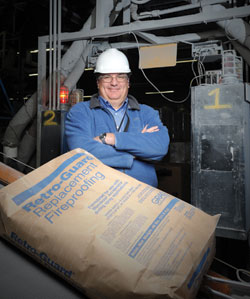
Steve Boss, site manager of Grace Canada, poses behind a conveyed bag of fireproofing product manufactured and packaged at the facility.
Formed in 1974, the company is one of North America’s leading manufacturers of high-quality fireproofing materials used primarily for the commercial construction industry—annually cranking out between 1.5 million and 2.2 million heavy-duty, 48-pound multilayer bags of high-grade, cement-based bulk powders blended and formulated to provide optimal preventative fire safety for builders across the continent.
“I would say that about 90 per cent of our business is with for the U.S. construction industry, as they tend to do a different type of construction there, utilizing more steel-based products than we do here in Canada, as well as having a larger amount of industrial projects on the go at any given time,” site manager Steve Boss told Canadian Packaging on a recent visit to the 64,000-square-foot facility Ajax operation, which employs 29 people on a two-shift, five-days-a-week schedule.
As part of the globally-operating construction products and services powerhouse Grace Construction Products, the Ajax facility is continually challenged to maintain the near-mythical reputation enjoyed by its parent company, founded by the Grace family, for more than 150 years, which it is doing superbly with the production of top-quality, asbestos-free Monokote MK-6 brand of fireproofing powder mixes.
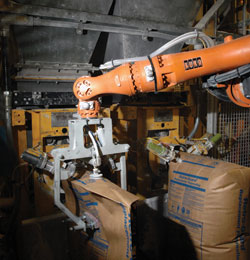
The KUKA KR5 Arc robotic system places an open-valve bag onto a Durant 100-E twin spout auger filler.
Making History
“In fact, our Ajax facility is playing a big part in the U.S. history right now, as our products are being used to fireproof the construction materials used to build the new Freedom Tower building, which will replace the fallen World Trade Center,” says Boss, adding that one of the founding company’s sibling, Russel Grace, was actually the mayor of New York when the city welcomed arrival of the Statue of Liberty from France back in 1886.
“Our asbestos-free Monokote cementitious fireproofing is both specified by architects and favored by applicators all over the world as a means to protect a building’s structural steel in the event of a fire,” Boss states. “Monokote is known for its performance and durability, and it is found in all types of nonresidential buildings like schools, hospitals, sporting facilities and high-rise constructions.
“The Monokote fireproofing products are a very formidable last line of defence in case there is a fire,” Boss asserts.
Comprising a mixture of cement, gypsum and other closely-guarded proprietary ingredients, the Monokote MK-6 is a monobase cementitious powder that is mixed with water to become a sprayable fire protective coating solution—to be applied by construction workers onto roofing, steel columns, and all other steel structures specifically required in the construction of hi-rises and other commercial buildings.
Boss says the products made at the Grace Canada plant incorporate a fair bit of recycled EPS (expanded polystyrene foam) in its products—allowing it to make a significant contribution to Ontario’s recycling infrastructure.
“Because EPS is one of the ingredients required for the manufacture of our cementitious fireproofing powder, Grace Canada purchases recycled materials from various Canadian municipalities and dumps them into a special shredder that has numerous heated wires criss-crossing its overhead mouth,” explains Boss.
The wires slice through the EPS like a hot knife through butter before a conveyor—using an adjustable-speed Speedmaster 2 AC motor control from Leeson Electric Corporation to direct its speed—moves the smaller chunks down the line for further shredding.
The re-shredded EPS material is then diverted to three separate production lines—each containing an E-Z Tec III Eriez Magnetics microprocessor-controlled metal detector that utilizes a differential transformer to detect pieces of metal to ensure that only the proper ingredients make it the manufacturing stage.
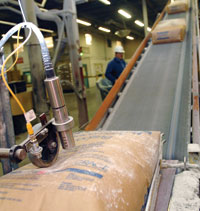
A Linx 4900 continuous inkjet coder applies lot code information to the front of a 48-pound bag of fireproofing powder.
“It’s a relatively simple process to manufacture our product,” says Boss. “Once we have our ingredients, we mix and blend them together before they are then sent indiscriminately to our two packaging lines.”
While the Ajax plant’s mixing and blending expertise in making this stuff has always been beyond reproach, according to Boss, its packaging capabilities were starting to get severely stretched a couple of years ago with the growing production volumes—resulting in productivity bottlenecks that he was determined to eliminate through the introduction of a robust, top-of-the line automation solution.
“It wasn’t until we decided to utilize robotics that we took a major step forward in the way Grace Canada did its packaging,” says Boss, recalling July 2009 installation of the high-tech, high-payload KR5 Arc robot system purchased from KUKA Robotics Canada Ltd., Toronto-headquartered subsidiary of leading German-based industrial robotics and material handling vehicles manufacturer KUKA Roboter GmbH to automate one of the plant’s two packaging lines.
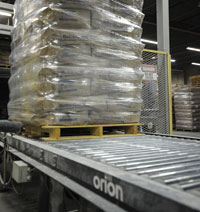
An Orion stretechwrapper safely secures the palletized load of 55 large bags of product in preparation for their shipment to customers.
Price is Right
Originally drawn in large part by the floor-mounted KR5’s attractive pricing and relatively small footprint—contained within a secure area of the production floor via safety fences and a lockable gate—Boss says he’s been supremely impressed by the immediate throughput and productivity gains enabled since the startup of the user-friendly, six-axis, jointed-arm kinematic system, as well as its user-friendliness.
“Not only are we able to virtually double our productivity, but its uptime is fantastic,” raves Boss. “Its consistency and efficiency is the whole reason I wanted to steer our business towards robotics.
“It can process up to 500 of our 48-pound bags an hour, filling them two at a time.
“Moreover, the Windows-based operating system is very simple to use,” says Boss, “and with its belt-driven servos it is definitely much more reliable than the older equipment we used before.”
According to Boss, who boasts prestigious Six Sigma Black Belt accreditation recognizing his advanced understanding of quality manufacturing processes and management, the key issue that any new robot would have to address at the Grace Canada plant would be its suitability for handling the kraft paper ‘open valve’-type multiwall bags supplied by Graphic Packaging Inc., which operates its Canadian business out of nearby production facilities in Brampton and Mississauga, Ont.
“I basically looked to develop the robot’s configuration around the design of the bag, which is an industry standard by virtue having been around for so many years,” recounts Boss, saying he had to do some inhouse design engineering himself to ensure that the KR5’s gripping attachment would execute the sequence of grasping a bag and placing it to the filling nozzle .
After the KR5 picks up an empty bag and places it to the output nozzle of the 100-E twin-spout auger filler, manufactured by Durant (now part of the Premier Tech Industrial Equipment Group), the fireproofing mixture is blown in through a slit in the bag, and is then quickly filled and tightly compressed to hold the contents intact without any mechanical or manual closures.
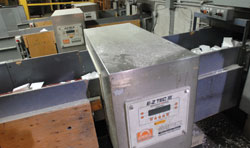
Recycled polystyrene running through one of three processing lines outfitted with the E-Z Tec III metal detection units made by Eriez Magnetics.
Each filled bag travels down a conveyor line—first passing by a Mettler Toledo JagXreme weigher and then past a large-character Linx Printing Technologies Ltd. 4900 continuous inkjet coder that applies lot code data to the front of the bag.
Continuing their journey along the conveyor, the bags are weighed a second time and, with any bag deemed too heavy or too light automatically rejected off the line, with its contents returned back to the filler for repacking.
All the accepted bags, meanwhile, are transferred onto a Durant palletizer—to be loaded onto pallets in 55-bag stacks—and moved onto a rotary-arm strechwrapping machine, manufactured by Orion Packaging, LLC, which swiftly rotates its arm around the loads to secure them in place for transport.
“We’ve not had any issues with the Orion machine, which is fast, accurate and provides us with exactly what we need to ensure our product arrives safely at the customer’s door,” says Boss while also praising performance capabilities of the companion model 2100X dual stretchwrapper, manufactured by Cousins Stretchwrapper Packaging Inc., installed in December of 2009.
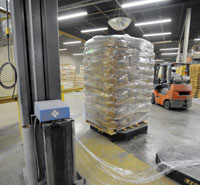
Grace Canada has recently installed a new model 2100X dual stretchwrapper from Cousins Packaging on its non-robotic packaging line.
“The Cousins stretchwrapper easily keeps up with our frenetic pace and the quality of the wrap has been more than adequate for our needs—ensuring that the customer always receives intact shipments from us,” says Boss.
While Boss thinks that the Cousins stretchwrapper is somewhat underutilized by being used on the second packaging line, which has not yet been automated with robotics, “I am already looking into the possibility of purchasing another robot when the time is right.”
According to Boss, there is a very good chance that second robot will also be a KUKA system.
“The good reputation that KUKA has is there for a reason—the technology they offer is based on some great engineering,” he states. “It also doesn’t hurt that it delivers the speeds we require here.
“While some people might consider having such high-tech equipment to fill up bags of powder something of an overkill,” he sums up, “we have found it to be a very positive experience.
“In my mind, there’s nothing wrong with having your company perform more efficiently and help it save financial resources through better manufacturing practices.”
Photos by Cole Garside
Advertisement

